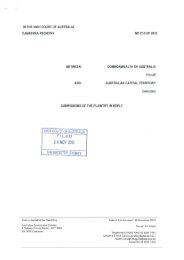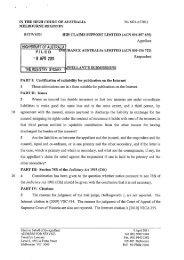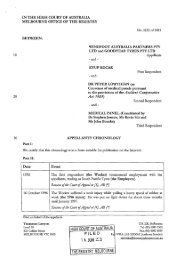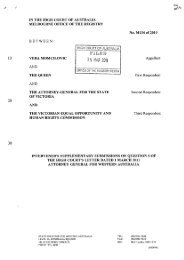Written submissions - High Court of Australia
Written submissions - High Court of Australia
Written submissions - High Court of Australia
You also want an ePaper? Increase the reach of your titles
YUMPU automatically turns print PDFs into web optimized ePapers that Google loves.
14<br />
Consistency in the punishment <strong>of</strong> <strong>of</strong>fences against the criminal law is "a reflection <strong>of</strong> the<br />
notion <strong>of</strong> equal justice" and "is a fundamental element in any rational and fair system <strong>of</strong><br />
criminal justice". It finds expression in the "parity principle" which requires that like<br />
<strong>of</strong>fenders should be treated in a like manner. As with the norm <strong>of</strong>"equaljustice", wb.ich<br />
is its foundation, the parity principle allows for different sentences to be imposed upon<br />
like <strong>of</strong>fenders to reflect different degrees <strong>of</strong> culpability aud/or different circumstances.<br />
(Footnotes omitted.)<br />
10 3 7. Whilst those remarks were made in the context <strong>of</strong> consideration <strong>of</strong> the principle <strong>of</strong> parity<br />
in sentencing <strong>of</strong> co-<strong>of</strong>fenders, they are equally ·apposite to the issues on the present appeal.<br />
The principle in R v Ling & Li promotes consistency- and thereby fairness and equal<br />
justice- in sentencing across the Commonwealth for <strong>of</strong>fending that relates to<br />
Commonwealth interests, whether <strong>of</strong>fenders are charged with State or Commonwealth<br />
<strong>of</strong>fences. 40<br />
38. The Commonwealth Parliament's intention: Thirdly, as indicated above, in R v Liang<br />
& Li, Winneke P said that it is "a relevant factor in the sentencing process to consider<br />
what the relevant legislative body (namely the Commonwealth) regarded as the<br />
20 appropriate 'sentencing tariff' for an <strong>of</strong>fence perpetrated against its interests or the<br />
interests <strong>of</strong> bodies for whom it had power to legislate". 41 The <strong>Court</strong> <strong>of</strong> Appeal considered<br />
these remarks, but opined that they could not explain the decision in R v Young, 42 which<br />
took account <strong>of</strong> the Commonwealth <strong>of</strong>fence solely because it was an identical <strong>of</strong>fence. 43<br />
But it is respectfully submitted that whether or not R v Young was correctly decided is not<br />
to the point. The fact is that the course <strong>of</strong> justice the appellants attempted to perve1i was<br />
in relation to the judicial power <strong>of</strong>the Commonwealth, 44 which behaviour fitted precisely<br />
the <strong>of</strong>fence contrary to s 43 <strong>of</strong> the Crimes Act 1914 (Cth). Further, the appellants'<br />
<strong>of</strong>fending included conduct across four states and internationally. In those circumstances,<br />
the Commonwealth <strong>of</strong>fence against s 43 was even more apt than the common law <strong>of</strong>fence<br />
30 charged. Thus, consistently with Winneke P's remarks, in sentencing the appellants on<br />
the <strong>of</strong>fence in Count 1, it was relevant to consider what the Commonwealth Parliament<br />
regarded as the appropriate "sentencing tariff" (viz, a maximum penalty <strong>of</strong> five years'<br />
imprisonment) for the <strong>of</strong>fence perpetrated against its interests for which it had legislated,<br />
namely the judicial power <strong>of</strong> the Commonwealth.<br />
40<br />
Similar issues have been considered in the United States <strong>of</strong> America. See DeMaso, C., "Advisory Sentencing<br />
and the Federalization <strong>of</strong> Crime:. Should Federal Sentencing Judges Consider the Disparity between State and<br />
Federal Sentences under Booker?", (2006) 106 Columbia Lmv Review 2095-2128.<br />
41<br />
R v Liang & Li (1995) 82 A Crim R 39 at 43.<br />
42<br />
R v Young (unreported, <strong>Court</strong> <strong>of</strong> Criminal Appeal (Vic.), Starke, Crockett & O'Bryan JJ, 2 December 1982).<br />
43<br />
Pantazis & Ors v The Queen [2012] VSCA !60 at [31]-[32] & [44]-[45].
















